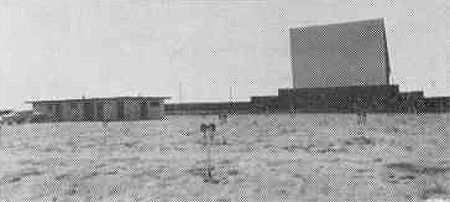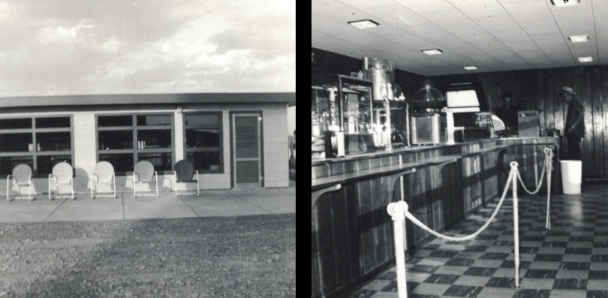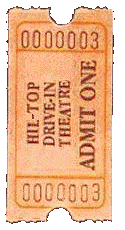The Hil'-Top Drive-In Theatre

 In late 1953, Ralph Larned decided it was time for Rush County to have a drive-in theatre.
In January 1954, he leased a ten-acre plot of ground at the south edge of LaCrosse from Loris Erbes. On June 15
of that year, the Hil'Top Drive-In, a 285-car outdoor theatre, opened to the public. The concession building was
twenty-two feet by fifty feet and included a projection booth, storeroom, and restroom facilities. A glass wall
on the front of the building allowed patrons to view the movie while waiting in the concession line. The cafeteria-style
concession stand featured pop-corn, hamburgers, hot dogs, AAA Root Beer, and a variety of other snacks. A playground
was situated behind the building. Movies were projected onto a Cinema-Scope-sized Boyer pre-fab screen that stood
fifty-six feet into the air with a picture area sixty-four feet wide and thirty-four feet high. The screen was
constructed of laminated lumber with white glatex shingles on the picture area. Two Brenkert BX-80 35mm Projectors
illuminated by Brenkert Carbon Arc lamphouses beamed movies onto the giant screen. Patrons could hear the movie
through individual Ballantyne in-car speakers mounted at each parking stall. The opening feature at the theatre was
Jubilee Trail, starring Forrest Tucker and Joan Leslie. The theatre was managed by Gordon Holiday and opening night
staff included: concession operators, Lillyann Suppes, Valta Ochs, Velma Kanage, and Kathryn Wilhelm; ticket cashier,
Della Parker; and projectionist, Robert Peterson.
In late 1953, Ralph Larned decided it was time for Rush County to have a drive-in theatre.
In January 1954, he leased a ten-acre plot of ground at the south edge of LaCrosse from Loris Erbes. On June 15
of that year, the Hil'Top Drive-In, a 285-car outdoor theatre, opened to the public. The concession building was
twenty-two feet by fifty feet and included a projection booth, storeroom, and restroom facilities. A glass wall
on the front of the building allowed patrons to view the movie while waiting in the concession line. The cafeteria-style
concession stand featured pop-corn, hamburgers, hot dogs, AAA Root Beer, and a variety of other snacks. A playground
was situated behind the building. Movies were projected onto a Cinema-Scope-sized Boyer pre-fab screen that stood
fifty-six feet into the air with a picture area sixty-four feet wide and thirty-four feet high. The screen was
constructed of laminated lumber with white glatex shingles on the picture area. Two Brenkert BX-80 35mm Projectors
illuminated by Brenkert Carbon Arc lamphouses beamed movies onto the giant screen. Patrons could hear the movie
through individual Ballantyne in-car speakers mounted at each parking stall. The opening feature at the theatre was
Jubilee Trail, starring Forrest Tucker and Joan Leslie. The theatre was managed by Gordon Holiday and opening night
staff included: concession operators, Lillyann Suppes, Valta Ochs, Velma Kanage, and Kathryn Wilhelm; ticket cashier,
Della Parker; and projectionist, Robert Peterson.
In spring of 1966, a tornado destroyed the original pre-fab screen forcing the theatre to close for the remainder of the season. The following year, a new steel screen tower was constructed. The Larneds reopened the theatre for a short period of time before closing it and moving to Texas in the late 1960s.
 In 1971, Sterling Bagby of Stockton and Steve Bagby of Hays took over operation of the theatre. The theatre struggled to remain open for three more seasons until permanently closing in the fall of 1973.
In 1971, Sterling Bagby of Stockton and Steve Bagby of Hays took over operation of the theatre. The theatre struggled to remain open for three more seasons until permanently closing in the fall of 1973.
After a fire destroyed the LaCrosse Country Club a short while later, the golfers utilized the concession building as a clubhouse until the mid-1980s. Until 1985, the drive-in still contained most of the original concession and projection equipment. In 1986, the box office, fences, and parking ramps were removed. Over the next decade, time and the elements began to take their toll. The building suffered considerable damage from water and rodents. In the summer of 2001, the concession building was dismantled leaving only the towering screen to serve as a monument to a once thriving business.
